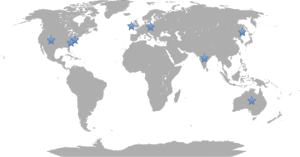 Years ago my friend, mentor and boss introduced me to the simple wonders of the candy jar effect. If you have a jar, basket, drawer, etc always supplied with candy, people across the organization will come to you. This is a great and super easy way to find out what’s going on in other parts of the organization, and with people in general. It also helps you develop an idea of what they like, so you can come bearing gifts when you need some assistance.
Years ago my friend, mentor and boss introduced me to the simple wonders of the candy jar effect. If you have a jar, basket, drawer, etc always supplied with candy, people across the organization will come to you. This is a great and super easy way to find out what’s going on in other parts of the organization, and with people in general. It also helps you develop an idea of what they like, so you can come bearing gifts when you need some assistance.
That said, I haven’t worked in an office full-time since 2008. With that in mind, I try to make sure i’m extra communicative. But, what about everyone else? Flexible work schedules are becoming more and more the norm, so how do you keep pulse on the organization and obtain all that knowledge you would have gained had you been in the office with a candy jar?
I have two separate thoughts on this spanning both sides of the spectrum. On one hand, I would argue that the people who are most effective in working remotely are often times their own “candy jar.” In my case, I find that people come to me with questions because they believe I have something to contribute. This allows me to get some of that additional information and continue to foster those connections outside of the immediate people I work with day in and day out.
But not everyone does a great job working remotely. I have had team members who were extremely difficult to figure out. Even the basics of determining exactly what they were working on, or how a project was progressing was difficult to ascertain. In this situation, I tried the daily stand up call. That helped a bit, but that was all the communication I got in the 24 hour period, unless I initiated it. An additional problem with the daily stand up call is that it gives you insights into the very specific yesterday’s work, today’s work and any roadblocks but doesn’t necessarily allow you to get a pulse on how the person is feeling.
As a manager, I think it’s my job to know what’s going on with my team. As a project manager, you may not be responsible for the team members but it’s still important for you to know the general pulse of the team. But in lieu of a better option, I think I’m stuck with doing my part to check in and ask. I’d love to hear if you have better suggestions.
What’s your virtual candy jar?
